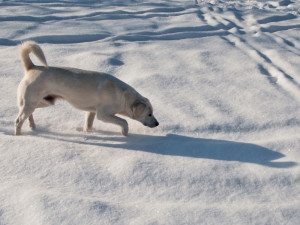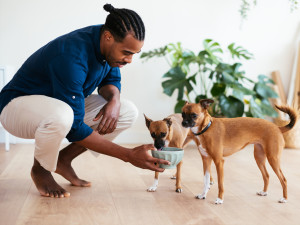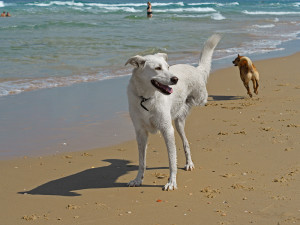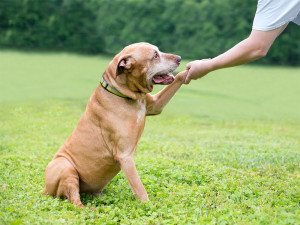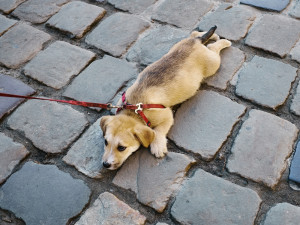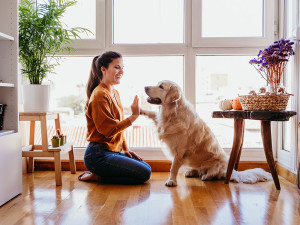6 Steps to Improve Your Dog’s Recall Training
Teach your pup a perfect recall so you can be sure they will come back, no matter what

Share Article
Dog recall training setbacks can be very disheartening. But when a dog doesn’t respond as you expect, it’s usually a situation in which a dog is asked to do something that they haven’t yet been trained to do. Responding appropriately to the cue to come to you when there’s nothing particularly new or interesting to distract them is totally different from returning to you when someone else is feeding them treats. So, how can you know when your dog has really ‘got it’ – so that you can be sure they will come back, no matter what?
Achieving perfect recall
The real secret to perfect recall training is that there are 100 steps involved in teaching a dog to return so that they can do it in any situation. Step one for teaching dog recall may be calling your dog to come from five feet away in your living room, with nothing else going on but you and your meatballs, and step 100 is calling your dog to come when they’re 500 feet away, chasing a squirrel or shadowopens in a new tab.

littleKin™ is Kinship’s home just for puppy and kitten parents. Bop over to check out expert advice, new pet tools, and special deals—all curated for your newest family member.
opens in a new tabMany people charge from step five to step 95 without realising what a challenge this is for a dog. This is the equivalent of asking a student to go from adding and subtracting to A-Level algebra, and wondering why they can’t do it.
Teaching a dog what a recall cue means is often the easiest part. Proofing the dog to that cue – or getting the dog to respond to a recall cue in all situations – is the challenge. Just because your dog has good recall and knows how to come when called when nothing else has captivated their attention doesn’t mean that they can do it when they’re really enthralled by the smell of a squirrel, the food they are eating or their best play buddy. Training your dog to come away from these distractions requires that you train them to do so in a series of steps of gradually increasing difficulty.
How to teach a dog recall
Avoiding recall setbacks by not skipping steps is a challenge that requires great discipline on your part. The key is that throughout your dog recall training work, you must not call your dog unless you are 100 percent confident that they will respond. For example, if someone is giving your pet treats, don’t try to call them back. Most trainers would tell you that the odds of success were not in your favour. Rather than call out “come back”, a wiser course of action is to simply go and get your dog. This is not convenient, I know. It requires only letting your dog off the lead in areas where you can get them if they don’t come, but keep in mind that it’s only temporary.
Your response is everything
When you call a dog to come and they don’t respond, how you handle the situation is important for your future success with dog recall training. If you do nothing, or if you keep calling them over and over, you’re teaching them not to respond unless they feel like it. Either they learn that they don’t have to come because there’s no consequence for not coming, or they learn to tune out the ‘come’ cue; it becomes background noise and loses its meaning to them.
One possible response is to go up to them, show them the meatball treat they could have had, and then walk away. Another is to take them out of the park so they learn that if they don’t respond, they don’t get to stay at the park.
A third possibility is to immediately set up a similar situation as a training opportunity. Put the meatball right up to their nose, move a few feet away and call them to come. Lure them with the treat if necessary – anything to get them to come away from the distraction, and then reinforce them for doing so. Then, allow them to go back to the distraction. Allowing your dog to get both reinforcements from you and what they gave up in order to come to you makes responding to your cue a winning situation all around.
Set them up for success
The most important factor in all dog training, but especially training dog recall, is setting up winning situations for your dog over and over again. in all sorts of contexts. That’s what proofing a dog for a training cue is all about.
During training, have something better than what they gave up, so they learn that coming to you is always worthwhile. This means that if someone is giving them liver biscotti, you give them chicken. If they give them a lot of physical attention, you give them a belly rub. If they are luring them with an ordinary ball, you reinforce them with a super-bouncy ball.
Proof your pup
It’s hard to know for sure that your dog is recall-proofed to respond to a cue in any situation if you haven’t explicitly practised and trained them to handle a variety of environments. That said, the more situations and types of distractions in which your dog has learnt to respond to the cue, the more likely it is they’ll respond appropriately in a novel context.
Six dog recall training steps
Certified applied animal behaviourist Dr Patricia B McConnell breaks recall training into six important recall training steps.
1. Prevention, prevention, prevention
It’s hard to compete once a dog has learnt that ignoring you means he gets to chase a squirrel or chow down a Big Mac wrapper.
2. Winning is everything
Start teaching a recall when you can’t lose. No distractions. Your dog is practically beside you. The perfect reinforcement.
3. Reinforce the turn towards you
If your dog was focused on a bird, but turns their head to you when you call, you’ve won half the battle.
4. Teach stop on cue
It only took me a couple of years of working with dogs to realise that, as mentioned above, dog recall includes several behaviours: stop what you are doing; change your focus on to me; turn around towards me; come towards me; all the way.
5. Repeat, repeat, repeat
Reinforce, reinforce, reinforce. Never stop reinforcing recall behaviour. Not every time, and not necessarily for responses when all the stars were aligned, but running and chasing is such a natural behaviour for a dog that stopping a chase and coming back to you is basically a circus trick.
6. Be realistic
Adolescent dogs are famous for forgetting everything they’ve learnt as a puppy, so don’t hesitate to go back to step one (prevention) for a few months, even if your dog was a star pupil as a youngster.
If you call your dog, and they visit with or slam into other dogs or even run in the other direction before getting to you, is that a perfect recall? No, but is that behaviour you should reward? Though it feels weird to reward a dog who takes so long to respond, you should definitely do so. While it isn’t the perfect recall you were looking for, you’ll need to reward your dog for leaving whatever was so interesting to return to you. If you don’t make them glad they did, they‘ll be even less likely to do so the next time.
Eventually, with hard work and training, all situations are sufficiently similar that they can be said to be ‘fully proofed’ for recall training. Some dogs get there faster than others, but for virtually every dog, it takes a lot of practice in a wide range of situations involving different places, different distractions and different distances.
Tips on teaching your dog a reliable recall
Training your dog to reliably return to you when called – any time, anywhere – could literally save their life, so it’s no exaggeration to say that a dog’s recall is the most important behaviour you will ever teach them. Here are a few dog recall training tips.
1. Play is one of the best reinforcements
If your dog learns that coming to you is fun, they’ll be more likely to respond. Call them to play tug or fetch, or let them chase you; even just running in the opposite direction often works because almost all dogs love to chase. (Don’t chase your dog; they’ll learn to move away when you approach, and that can ruin their recall.)
2. Not all dogs are equally easy to train
It’s more challenging for some dogs to learn to come when called, and while there are exceptions, here are a few breed generalisations that usually fit. Dogs bred to work closely with people and pay attention to them during that work – Collies, Shepherds and Retrievers – are often easier to train with dog recall. Dogs bred to work independently – Terriers, scent and sight hounds, Mastiffs and Pointers – often require more practice and time for the recall to be completely proofed.
3. Change your cue
If your dog has learnt that the word ‘come’ has no meaning and they ignore it, consider changing the verbal cue. If a word has become irrelevant, it’s often more efficient to start over. Common recall words include ‘here’, ‘front’ and ‘ven’ (Spanish for ‘come’).
4. Dogs need to generalise
Practice in many contexts is important. Place, a key factor, is particularly hard for many dogs to generalise. A recall in your back garden is completely different than a recall inside the house, and a recall at the park is completely different than a recall at home – inside or out. Other factors include distance (how far you are from your dog when calling them) and distraction level (food, other people, sounds, traffic, toys or other dogs). Plan to train your dog everywhere – that way, they’ll be more likely to respond, no matter what.

Karen B. London, PhD, CAAB, CPDT-KA
Karen B. London, Ph.D., is a Certified Applied Animal Behaviorist and Certified Professional Dog Trainer who specializes in working with dogs with serious behavioral issues, including aggression, and has also trained other animals including cats, birds, snakes, and insects. She writes the animal column for the Arizona Daily Sun and is an Adjunct Professor in the Department of Biological Sciences at Northern Arizona University. She is the author of six books about training and behavior, including her most recent, Treat Everyone Like a Dog: How a Dog Trainer’s World View Can Improve Your Lifeopens in a new tab.
Related articles
![Man crouching down to let two dogs eat out of a bowl]() opens in a new tab
opens in a new tabHow Many Treats Is Too Many?
The key to curbing mindless snacking – according to a veterinarian
![Three-legged white dog at the beach]() opens in a new tab
opens in a new tabHow to Keep Your Three-Legged Dog Outpacing All the Other Pups at the Park
Six tips to help your tripod dog stay in tip-top shape
![A senior Retriever/Terrier mixed breed dog shaking hands with its owner.]() opens in a new tab
opens in a new tabHow to Teach an Old Dog New Tricks
Your senior dog might move slower these days, but that doesn’t mean they can’t learn new things
- opens in a new tab
“How Do I Get My Puppy to Stop Biting My Ankles?”
Dog trainer Robert Haussmann’s tips for dealing with an attention-seeking puppy
![Dog lying on a brick street with a leash]() opens in a new tab
opens in a new tab“Why Won’t My Dog Walk Outside?”
Dog behaviourist Karen B London’s top tips to help get your parked pet moving
![A woman holding a dogs paw and smiling.]() opens in a new tab
opens in a new tabNine Useful Tricks to Teach Your Dog
Go beyond the basics

